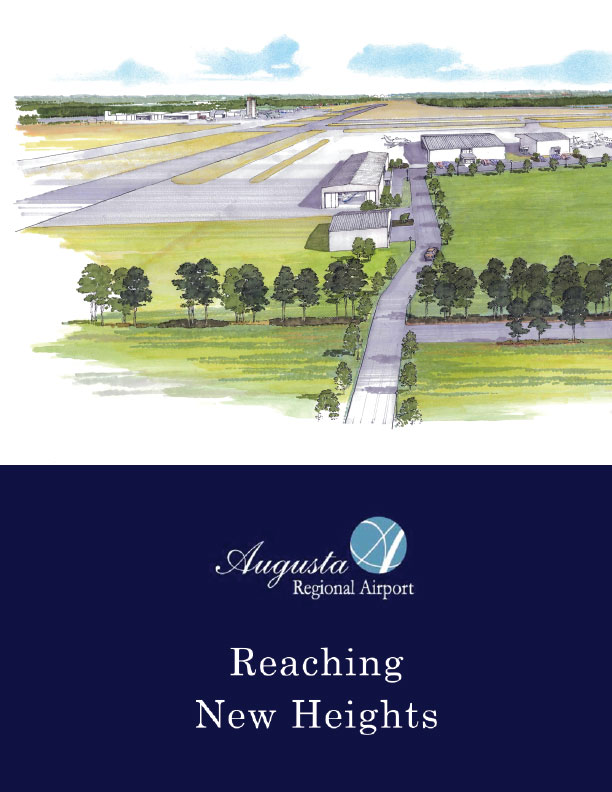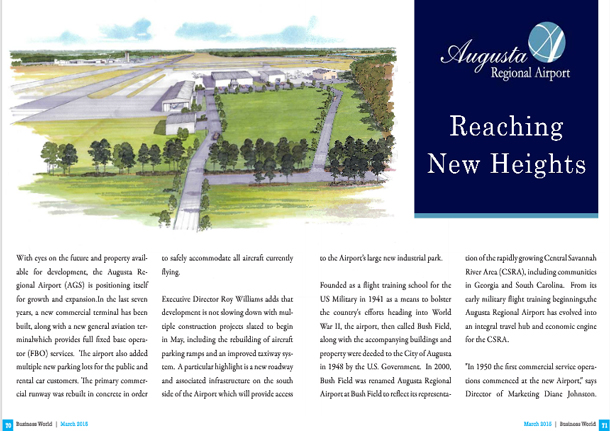Reaching New Heights

With eyes on the future and property available for development, the Augusta Regional Airport (AGS) is positioning itself for growth and expansion.In the last seven years, a new commercial terminal has been built, along with a new general aviation terminalwhich provides full fixed base operator (FBO) services. The airport also added multiple new parking lots for the public and rental car customers. The primary commercial runway was rebuilt in concrete in order to safely accommodate all aircraft currently flying.
Executive Director Roy Williams adds that development is not slowing down with multiple construction projects slated to begin in May, including the rebuilding of aircraft parking ramps and an improved taxiway system. A particular highlight is a new roadway and associated infrastructure on the south side of the Airport which will provide access to the Airport’s large new industrial park.
Founded as a flight training school for the US Military in 1941 as a means to bolster the country’s efforts heading into World War II, the airport, then called Bush Field, along with the accompanying buildings and property were deeded to the City of Augusta in 1948 by the U.S. Government. In 2000, Bush Field was renamed Augusta Regional Airport at Bush Field to reflect its representation of the rapidly growing Central Savannah River Area (CSRA), including communities in Georgia and South Carolina. From its early military flight training beginnings,the Augusta Regional Airport has evolved into an integral travel hub and economic engine for the CSRA.
“In 1950 the first commercial service operations commenced at the new Airport,” says Director of Marketing Diane Johnston. “Bush Field began to grow and we welcomed the Airport’s first big tenant in 1975. Originally Capital Aviation, StandardAero provides extensive aircraft maintenance and upgrade services, and now they are our largest tenant, employing approximately 200 aircraft mechanics and support personnel.”
Committed to their Community
During the planning stages of the new commercial terminal, completed in December 2007, the community had a large say in creating a space which accurately showcased the unique qualities of Augusta, Georgia. Williams, whose experience extends across many years and airports around the US and the world, says that retaining the feel of a community within a functioning airport is about more than buildings alone.
“It’s a real challenge to combine all of the functionality issues of an airport and still produce a distinctive flavour,” he says. “Some places do that with architecture, we go beyond that, with the experience, to be Augusta specific.”
“One of the things that we heard from our community as we were undergoing the design process was they wanted it to reflect the character of the community,” Johnston says.”So the buildings are reflective of Georgian architecture, the real classical feel that you would get from the Deep South.”
In keeping with Augusta’s nickname, “The Garden City”, the airport also focused on creating beautiful outdoor spaces with gardens and patios.
“We have some beautiful gardens in our commercial terminal. Once past passenger screening, you can step out onto several balconies and enjoy sitting outdoors, watching our little waterfall and stream, or just enjoying the breeze and being outside while you’re waiting for your aircraft,” Johnston adds.
Crafting a distinctive character for the airport goes beyond architecture and landscape alone. It’s about the experience each passenger has, and Augusta Regional Airport wants their travelers to arrive and depart with a true sense of Augusta and its culture.
In order to showcase some of the local flavor, the airport developed an art program in 2012. The program features live performances by local musicians at peak times of the year, including during the annual Masters PGA golf tournament in April, as well as the week leading up to Christmas. During off-peak times, the music plays on, as the artists provide a local concert series once a month. Augusta Regional Airport not only spotlights musicians from the area, but visual artists as well showcasing local artists in display cases found in both the commercial and FBO terminals.
The Future of Augusta Regional Airport
Along with the relocation ofUS Army Cyber Command to Fort Gordon, the continued growth of the NSA and the consolidation and expansion of University of Augusta and Georgia Regents University, growth in the CSRA is exploding. As the Airport continues to grow with the region, looking toward the future will mean addressing challenges that lie ahead in the area of expansion of facilities and infrastructure, along with diversification of the revenue stream, according to Williams.
“Our expectation is that many businesses will want to relocate to the CSRA in support of the military and medical expansion currently under way in our area,” explains Williams. “Many of these new businesses will have private aircraft or need hangar access or will be very dependent on our Airport for commercial air service. Thankfully, we have a terminal that is easily expandable, available developable land and a community that is very supportive of our economic development efforts.”
The Airport is well positioned to attract new development with its proximity to the Ports of Charleston and Savannah, the CSX-Norfolk Southern Railroad running adjacent to Airport property, and interstate highways I-520 and I-20 just a couple of miles from the Airport entrance. Additionally, the Airport has an 8,000 foot primary runway that will accommodate any aircraft flying today. There are hundreds of acres of property currently available for development in parcel sizes ranging from one acre up to 140 acres with a new industrial park being developed on the south side of the Airport which could be used for aviation related businesses or aerospace related manufacturing facilities. Augusta Regional Airport already owns the land, and 2015 seems to be the right time for the project to take off, with construction and marketing being key focuses.
“We’re getting ready to start construction on a roadway along with the utilities and infrastructure necessary to open up the industrial park,” Johnston says. “We have approximately 150 acres on the south side of the Airport that we’re looking to market. We are currently undergoing the environmental studies right now so the property will be shovel ready for any business needing a quick start. We expect to break ground on the construction project within the next six months.”
“It’s a really big opportunity, it’s important for the community and I think within five years we can do that,” Williams says of developing the land. “With access to rail, ports, and highways, we should be very attractive to aviation related businesses looking for a place to operate. StandardAero, a world class MRO facility, located on the field and the Airport’s first class Fixed Base Operator which provides fueling and support service are added benefits, providing necessary support for new aviation businesses.â€
Through their commitment to the community, and the highest quality customer service, it’s clear that Augusta Regional Airport has a bright future ahead of it. With passion and dedication, the airport will continue to expand and exceed expectations.








